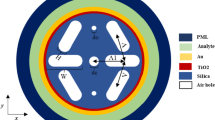Abstract
The results of studying neutron signals from scintillation detectors based on a \({{^{6}{\text{LiF}}} \mathord{\left/ {\vphantom {{^{6}{\text{LiF}}} {{\text{ZnS}}({\text{Ag}})}}} \right. \kern-0em} {{\text{ZnS}}({\text{Ag}})}}\) screen and wavelength-shifting fibers are presented. It is shown that the complex shape of the neutron signals arises from a low signal amplitude and fluctuation of photoelectrons in the process of light collection from the scintillator surface using optical fibers. A charge method for neutron detection using digital signal processing is proposed, which allows an appreciable increase in the detector efficiency at a high counting rate. The calculated efficiency of neutron signal discrimination at a neutron event intensity of (\( \approx {{10}^{6}}\) n/s) is ε = 0.42. To compare, the efficiency of the classical discrimination method with nonparalyzable dead time is ε = 0.33.








Similar content being viewed by others
REFERENCES
A. Kreyssig, K. Irmer, and U. Hartung, “ZnS/6Li scintillation material as an alternative to 6Li-glass scintillators for neutron detection in time focusing geometry,” Nucl. Instrum. Methods Phys. Res., Sect. A 349, 292–294 (1994). https:// “www.sciencedirect.com/science/article/pii/0168900294906378.
A. V. Belushkin, A. A. Bogdzel, V. I. Bodnarchuk, O. Daulbaev, V. V. Zhuravlev, A. K. Kurilkin, S. A. Kulikov, E. I. Litvinenko, V. M. Milkov, M. O. Petrova, V. I. Prikhod’ko, M. M. Podlesnyy, A. V. Churakov, and V. V. Shvetsov, “Experience in the development and production of thermal-neutron detectors at the IBR-2 DSC (Review),” Instr. Exp. Tech. 65, 539–550 (2022). https://doi.org/10.1134/S0020441222050025
“Lithium-6 based screens for detection and imaging of thermal neutrons,” https://scintacor.com/wp-content/uploads/2021/09/Scintacor-Neutron-Screens-Dec16.pdf.
C. Combes, P. Dorenbos, R. Hollander, and C. Eijk, “A thermal-neutron scintillator with n/Oi discrimination LiBaF3:Ce, Rb,” Nucl. Instrum. Methods Phys. Res., Sect. A 416, 364–370, (1998). https:// www.sciencedirect.com/science/article/pii/S0168900298007645.
A. A. Bogdzel, V. A. Drozdov, V. V. Kruglov, S. M. Murashkevich, V. I. Prikhodko, and V. V. Shvetsov, “The new data acquisition system MPD-32 for the High-Resolution Fourier Diffractometer at the IBR-2 pulsed reactor,” in Proceedings of the 27th International Symposium on Nuclear Electronics and Computing (NEC’2019), 2019.
K. Pritchard, J. Chabot, P. Tsai, R. Robucci, F. Choa, A. Osovizky, J. Ziegler, E. Binkley, N. Hadad, M. Jackson, C. Hurlbut, G. Baltic, C. Majkrzak, and N. Maliszewskyj, “Measuring deadtime and double-counts in a non-paralyzable scintillating neutron detector using arrival time statistics,” Nucl. Instrum. Methods Phys. Res., Sect. A 1001, 165270 (2021). https://www.sciencedirect.com/science/article/pii/S0168900221002540.
A. S. Chepurnov, M. A. Kirsanov, A. A. Klenin, S. G. Klimanov, and A. S. Kubankin, “Digital pulse shape discrimination between fast neutrons and gamma rays with para-terphenyl scintillator,” J. Phys.: Conf. Ser. 934, 012057, (2017). https://doi.org/10.1088/1742-6596/934/1/012057
N. Zaitseva, A. Glenn, H. Paul Martinez, L. Carman, I. Paweczak, M. Faust, and S. Payne, “Pulse shape discrimination with lithium-containing organic scintillators,” Nucl. Instrum. Methods Phys. Res., Sect. A 729, 747–754 (2013). https://www.sciencedirect.com/science/article/pii/S0168900213011741.
P. Q. Vuong, H. J. Kim, A. Khan, S. Khan, S. H. Kim, H. Park, and J. Kim, “Silver-doped LiI crystal: A sensitive thermal neutron detector with pulse shape discrimination,” IEEE Trans. Nucl. Sci. 67, 2290–2294 (2020).
M. J. Balmer, K. A. Gamage, and G. C. Taylor, “Comparative analysis of pulse shape discrimination methods in a 6Li loaded plastic scintillator,” Nucl. Instrum. Methods Phys. Res., Sect. A 788, 146–153 (2015). https:// www.sciencedirect.com/science/article/pii/S0168900215 004532.
Caen N6730 Digitizer. https://www.caen.it/products/ n6730.
WaveRunner8054-MS. http://teledynelecroy.com/oscilloscope/waverunner-8000-oscilloscopes/waverunner-8054-ms.
Funding
This work was supported by ongoing institutional funding. No additional grants to carry out or direct this particular research were obtained.
Author information
Authors and Affiliations
Corresponding author
Ethics declarations
The authors of this work declare that they have no conflicts of interest.
Additional information
Translated by M. Potapov
Publisher’s Note.
Pleiades Publishing remains neutral with regard to jurisdictional claims in published maps and institutional affiliations.
Rights and permissions
About this article
Cite this article
Podlesny, M.M., Kruglov, V.V., Bodnarchuk, V.I. et al. Method with Digital Signal Processing for Increasing the Efficiency of Thermal Neutron Detection by a Scintillation Detector Based on a \({{^{6}{\text{LiF}}} \mathord{\left/ {\vphantom {{^{6}{\text{LiF}}} {{\text{ZnS}}({\text{Ag}})}}} \right. \kern-0em} {{\text{ZnS}}({\text{Ag}})}}\) Screen and Wavelength-Shifting Fibers. Phys. Part. Nuclei Lett. 21, 146–153 (2024). https://doi.org/10.1134/S1547477124020109
Received:
Revised:
Accepted:
Published:
Issue Date:
DOI: https://doi.org/10.1134/S1547477124020109




